Last March opened up a new favorite dive destination to me – South Africa. It instantly sky-rocketed to one of my top favorite places in the world to visit and dive. This particular trip was billed “Sharkaholic Expedition” and focused on the sharks of three different habitat types. Each habitat type featured at least one primary shark species, and each area was full of opportunities for fun, exciting moments in the water. So rather than try to summarize and zip too quickly through my entire week of diving in one blog post, I’ll break up my narrative into three posts – one for each habitat type.
As soon as I start to tell people about diving in South Africa, one of the most common interruptions I get is a very curious / anxious / fearful query about great white sharks. I’ll get to that part next week. This week, I’m going to focus on the pelagic species in the blue water south of Capt Point – specifically, the blue shark. We also hoped to see mako sharks, but it turned out only one was spotted on the trip (by me, actually — I spotted it breaching from a distance).
On our first day of diving – also our first full day in town – we boarded one of the smaller boats from Shark Explorers’ fine fleet and headed out to sea. Not a single person on the boat bothered with seasick meds. After all, most of us were experienced boat divers who never got sick. On our way out, we witnessed a beautiful sunrise and caught sight of a humpback whale. We motored past Boulders Beach, where the penguins live, kept steaming south past Cape Point, then headed for the warm blue waters of the Agulhas Current.
It didn’t take long before one of the two guys who were not part of our group started retching. I thought: Poor guy. I thought: Wimp. Waters were rough and I had to practically tie myself down to keep from flying with each wave we hit. But no big deal, right. We slashed through wave after ocean wave until we finally reached the shark grounds, 40 kilometers from Cape Point.
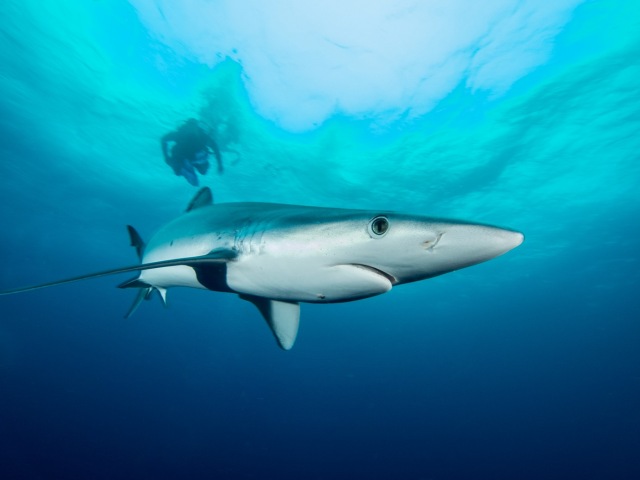
Blue shark with one of the Sharkaholics.
When the boat ceased forward motion, the crew went to work chumming for the blue sharks. As soon as they did, the pelagic birds came in and put on a show that birders would pay a lot of money to see: Albatross, Petrels, Shearwaters, Fulmars. I was thrilled, though the water was far too rough to even attempt to take photos. I watched in joyful awe. Plus the birds took my mind away from the confused seas we found ourselves in. And they were confused — they were so terribly, terribly confused.
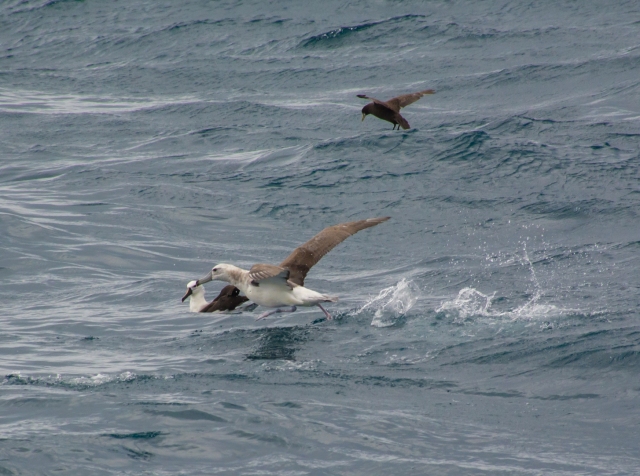
Atlantic Yellow-nosed Albatross and Black-browed Albatross! With a petrel in the background.
Sometime about then something in me shifted, and my focus went away from the birds and directly to my stomach. The confused seas nailed me. (My dive log reads: “…the confused seas were not kind to the constitution.”) And, the smell of chum got to the remaining non-staff people on the boat – eventually, everyone on board who was not associated with Shark Explorers gave back to the sea that day. Every one of us. I gave three times, that’s how generous I was.
So, word to the wise. If you are going on a blue-water expedition off Cape Point – the word is Bonine.
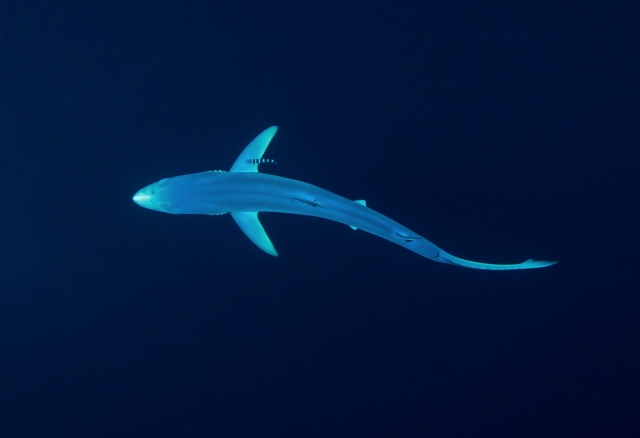
Blue shark with pilot fish, from above. Yes, the water is blue. But so is the shark — that really is its color.
Our dive briefing was unlike any I’d ever heard. It went something like this: “Blue sharks are incredibly curious animals. And they have only one way to test their curiosity: their mouths. So you have to interact with these sharks. They will come at you, and you have to touch them – you have to push them away. Don’t stick your hands in their eyes, gills, or mouths, but anywhere else is fine, just push them away. If they do get their mouths on you, first you will barely feel them, but if you don’t knock them away, they will bite down a little harder and might scratch you, but then if you don’t push them away, they’ll bite down all the way, and then they won’t want to let go; don’t let it get to that.” Um.
I was the only person on the trip using a drysuit and was a little alarmed at the thought of curiosity chomping holes through my shell. But they said I’d be fine if I just stayed alert. Never mind the mouth-shaped holes in our guide’s suit, complete with zig-zag teeth-shaped marks.
It did not take long before longfin tuna began showing up, and the blue sharks were fast on their tails. We were all dying to get in the water – perhaps not literally, but it sure felt like it. It took a while for everyone to get in for various reasons, and I was the last one in. In the end, entry was kind of chaotic, the ocean was bottomless, we jumped in with a mess of sharks that we were instructed to fend off constantly, and this was our first dive of the trip – our check-out dive! What could possibly go wrong?
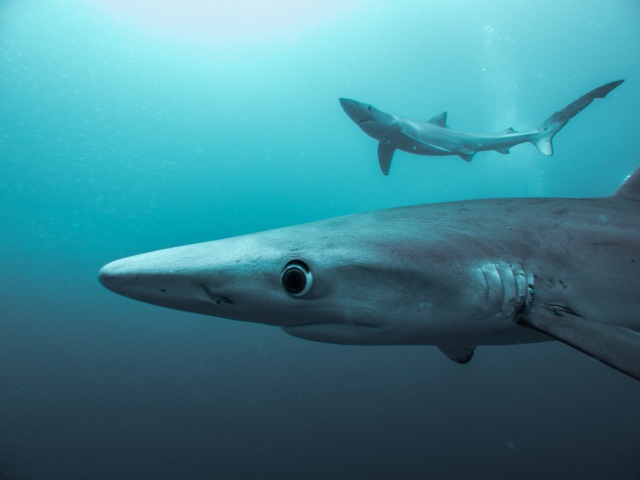
Two blue sharks.
Fortunately, nothing went seriously wrong. But that night over dinner, we discovered how many little things did go wrong – just like a check-out dive is meant to. I was under-weighted and suffered drysuit squeeze the whole time just to stay submerged. One person’s mask fogged the whole time. One person’s strobe didn’t work. Stuff like that. But during the dive, the sharks did not seem as curious as we’d been warned. I used my strobes to block any on-coming sharks, but it was no big deal. It was pretty calm overall. I logged 52 minutes in water 66 degrees F.
The sharks? Stunning. Absolutely stunning. Such a beautiful blue I could not have guessed. And they look you in the eyes, kind of the way a puppy does as it’s testing boundaries with its new human. They swim directly at you, looking at you the whole time. You get locked in, even if only briefly. Some are shy, some sneak up on you. But those eyes… nearly hypnotizing.

Beautiful blue shark — look at it looking into my very soul.
After this first day, I took Bonine every single day of the trip without fail, even though I probably didn’t need to most days. Several days later we did a second blue shark trip, and the Bonine was priceless. It was a long day because we couldn’t find the sharks. The guys chummed twice and still no sharks. I dozed on and off. We were out for hours searching… We stopped a third time after traveling a long ways yet again — by this time we were 50 kilometers offshore. Finally, our leader spotted one blue shark and jumped in the water with his speargun to catch a longfin tuna so we could continue. It worked. Soon there were two blue sharks, so they put us in the water. Then BAM! Tons of sharks suddenly.
And what a difference a day makes!
The water was a tad cooler, the sharks had been harder to find, no one got sick (because everyone took seasick pills), and on this day the sharks were as curious as we had been warned they could be. Wow were they curious! Wow did I ever have to interact. Everyone did. They came at you from every direction, and you had to constantly push them away. It was fine and all, but this was not a dive you could relax during – you had to be on constant alert, because they can sneak up from behind, from below, from all angles at once. But just so long as you push them away, no problem. Constantly running defense — it kept you sharp. It kept me breathing through my tank way too fast.
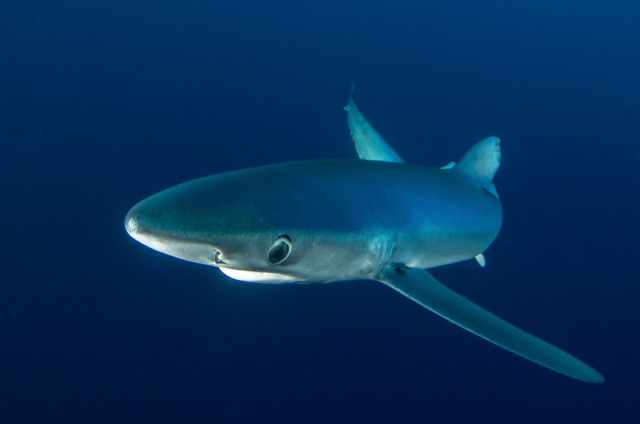
Blue shark, mouth poised for curiosity.
Several of the sharks had pilot fish with them – it was so cool when I realized that the striping on the pilot fish matched the gills of the sharks – that is, a predator might see the pilot fish and think it was nothing but the shark’s gills. Incredible.
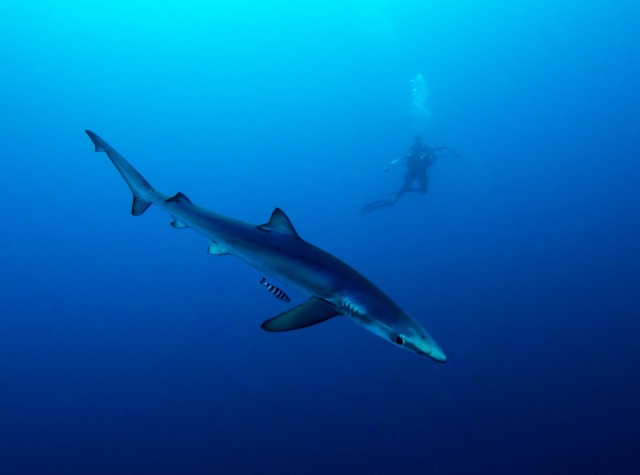
Blue shark with pilot fish. Compare the shape and coloration of the pilot fish to the gills of the shark!
One of the blue sharks on this second trip knocked my strobe into TTL mode and I was confounded at the suddenly horrible lighting. Dude, really? And, okay, once I turned away for a moment and looked back to discover a shark biting at my strobe. I screamed like a girl. Such is the power of reflex. In the end, no pun intended, no holes in my drysuit!
An amazing super surprise on this second day was the appearance of a magnificent, massive yellow-fin tuna. These fish can get up to 400 pounds, so we are talking big. This is easily one of my favorite fish in the ocean. Easily one of the most charismatic, most beautiful – will stop you in your tracks. And one visited us this day.

Yellow-fin tuna. This one was maybe 4 feet long. It came right at me, but I did not have to interact with it.
On the second blue-shark day, we were picked up at 7:30 in the morning and did not get back until 4 that afternoon. Total bottom time logged: 49 minutes. And it was completely worth it. Completely, utterly worth it.
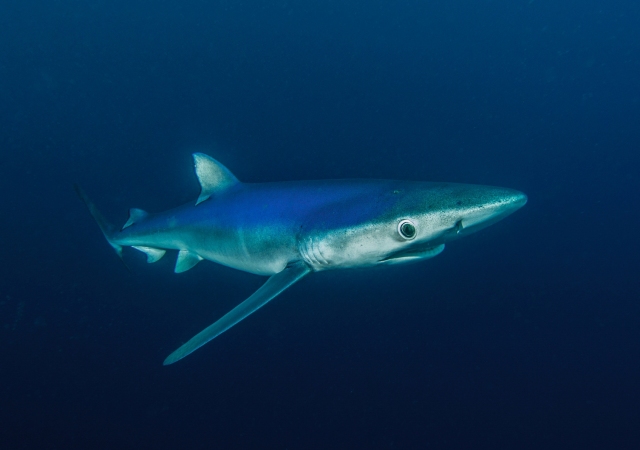
The beautiful blue shark, Prionace glauca.

Pingback: White Shark Habitat | SeaJen